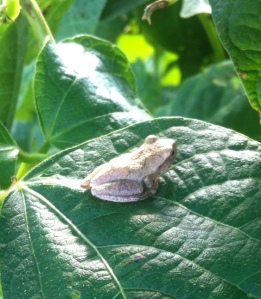
This peeper probably came from a vernal pool across the corn and hay to find our bean patch. Hope it likes Mexican bean beetles because that’s what we’re serving.
The windshield wipers whap back and forth as I drive home on a warm late-summer evening. It’s only 8 p.m., but already middle-of-the-night dark. The rain has slowed to a drizzle when my headlights catch something on the road. It hops and I swerve.
They don’t teach you this in driver’s ed, how to avoid migrating frogs on warm, wet nights. Unfortunately many drivers don’t avoid them – carnage I can attest to from my morning bike rides. But I do, or at least try.
It takes a ridiculous amount of time to drive the five miles from the highway to our house. It seems like frogs are everywhere, hard to distinguish from rain drops hitting the road.
In spring some frogs and salamanders cross the roads in a Big Night. When the weather warms enough to melt their vernal pools and there’s a good soaking rain, they set out for their home ponds from where they wintered. That’s usually in a log or on a forest floor wrapped in leaf litter. Unfortunately, there’s often a road in the way.*
Likewise In late summer and fall, frogs take advantage of wet weather to reverse their steps. They return to autumn hunting grounds and winter quarters, which again often requires that jaunt across the road.
When I pull in the driveway, I call for my son and we grab raincoats and wellies and headlamps: we’re going out on frog rescue. Our lights illuminate several wood frogs hopping across our road, which is a little odd because the nearest vernal pool is at least 1/4 mile. away They have traversed an entire field of hay and corn to get here.
We sneak up and encourage them to keep moving. If there’s a car, we pick them up to hurry it along.
Here in central Maine most of the frogs out on the roads are wood frogs and spring peepers. There might be the occasional green, pickerel or leopard frog, but they are aquatic species and don’t like to be far from water. If they’re on the move it’s usually to disperse to other ponds. (Wood frogs and peepers are classified as terrestrial frogs because they actually spend most of their time in the woods. Who knew.)
Tonight, frogs are not the only creatures out and about. Bats are foraging too, swooping low over the road for moths and mosquitoes as they make their way to wintering caves. We’re glad to see them after a summer’s absence–ours seem to have vanished just like everyone else’s. In fact Maine has lost 90 percent of its bat population to white nose fungus, according to Maine Audubon.
For a few minutes we stand in the road and watch as they zoom around and among us. It’s nice to be out with the bats and frogs as we say goodbye to summer. Like these creatures, we’ll also need to hunker down for what’s next.
*Some communities have Big Night events to help safeguard those crossings. Some have even installed tunnels to encourage amphibians and turtles to cross underground.
